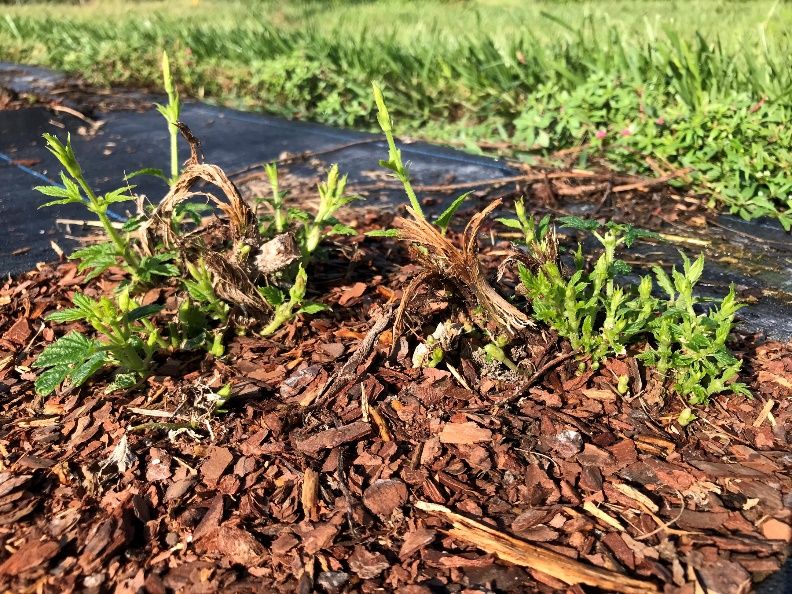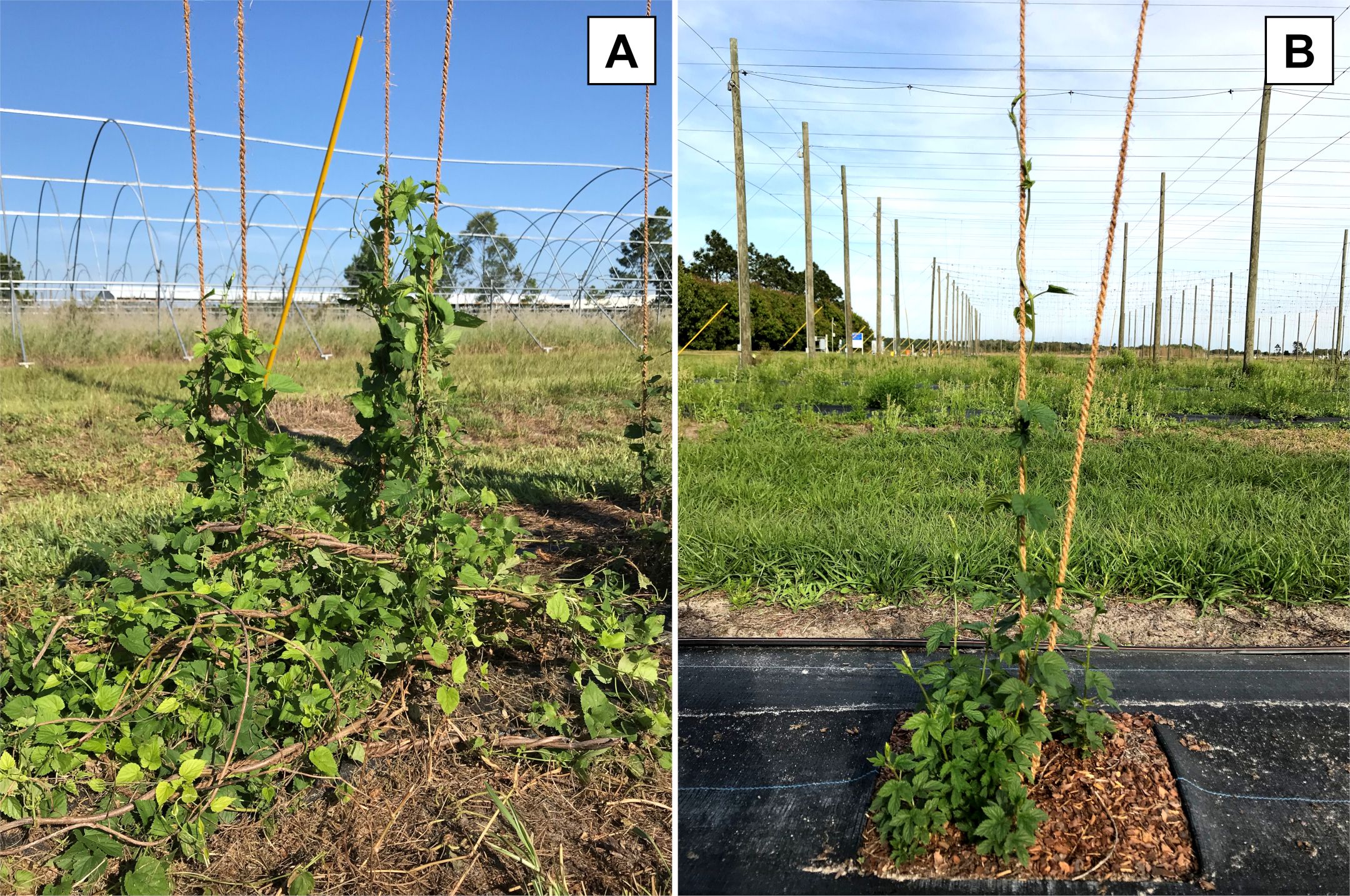Hops (Humulus lupulus L.) are perennial herbaceous plants that develop twining stems called bines. After harvesting, bines need to be pruned properly to enhance the crop performance in the following season. In Florida, hops have two growing seasons per year, and different pruning practices are recommended after each season. This article explains why, when, and how to prune hops in Florida. It is part of a series that examines the challenges and opportunities of hop production in Florida based on research at the UF/IFAS Gulf Coast Research and Education Center (UF/IFAS GCREC).
A corresponding tutorial video is available at https://www.youtube.com/watch?v=yyMyN117eO4. Additional videos on hop production and management are also available at the UF IFAS Horticultural Crop Physiology Lab YouTube channel (https://www.youtube.com/channel/UCMyYAfFZsib6d4ZI-eaxCTQ). The intended audience for this article includes growers, certified crop advisors, crop consultants, and UF/IFAS Extension faculty.
Why prune hops?
In commercial hopyards, bines of hop plants are trained to grow vertically on a tall trellis, which is typically 18 to 20 ft above the ground (Mabie 2021). At harvest, bines are removed from the trellis, except for the bottom 3 to 4 feet section. It is important to prune the remaining bines because of the following benefits:
- More space for new bine growth
- Prevention of new bines from being tangled with old bines
- Promotion of new growth from the crown instead of the nodes of the remaining bines (after the spring harvest)
- Easier access for field management (e.g., weeding, pine bark application, twine installation, etc.)
- Removal of pests and pathogens from the field
- Increased air circulation to reduce disease development
When to Prune
Florida’s subtropical climate and flowering control using supplemental lighting enable double-season production of hops (Agehara 2000; Agehara et al. 2021). Spring and fall growing seasons for ‘Cascade’ hops run from February to June and June to November, respectively (Figure 1). Plants senesce after the fall harvest and go dormant around mid-December. The video describing spring and fall growth cycles of hops in Florida is available at https://youtu.be/_rAnXr3cQrs.
The timing of pruning is critical for successful crop performance in the following season. The optimum time to prune differs between spring and fall seasons because of different postharvest growing conditions (Figure 1).

After the Spring Harvest
Prune all the remaining bines at the ground level immediately after the spring harvest. New bines will quickly emerge from the crown (Figure 2).

Credit: Shinsuke Agehara, UF/IFAS
After the Fall Harvest
After the fall harvest, leave unharvested bines to senesce in the field (Figure 4), so that nutrients in stems and leaves can be translocated to roots (Aerts 1996). When the bines are entirely dried out (typically in mid-January), prune them back at the ground level.

Credit: Shinsuke Agehara, UF/IFAS
How to Prune
Pruning height is critical for promoting healthy new bine growth in the following season. Use hand pruners to cut off bines at the ground level (Figure 4A) to encourage the emergence of new bines from the crown (Figure 2). If bines are not pruned after the spring harvest, many spindly bines will emerge from the nodes of unharvested bines (Figure 5A).

Credit: Shinsuke Agehara, UF/IFAS

Credit: Shinsuke Agehara, UF/IFAS
Pruned bines and debris should be removed from the field immediately after pruning (Figure 4B). It will create more space for new bine growth (Figure 5B) and prevent new bines from being tangled with old bines. It will also help eliminate pests and pathogens from the field (Figure 5A). Mealybugs are one of the pests that try to overwinter at the base of bines (Figure 6).
Disinfecting your garden tools is a good way to prevent the spread of diseases, especially when pruning green bines after the spring harvest. For more information about disinfecting garden tools, see https://gardeningsolutions.ifas.ufl.edu/care/tools-and-equipment/disinfecting-tools/ (University of Florida 2022).

Credit: Shinsuke Agehara, UF/IFAS
Summary
Postharvest pruning is one of the important cultural practices in hopyard management. Proper postharvest pruning can not only enhance the following season’s crop performance but also improve pest management and facilitate other cultural practices in the hopyard.
Literature Cited
Aerts, R. 1996. “Nutrient Resorption from Senescing Leaves of Perennials: Are There General Patterns?” J. Ecol. 84:597–608.
Agehara, S,. 2020. “Using Supplemental Lighting to Control Flowering of Hops in Florida.” EDIS 2020 (2). HS1365. https://doi.org/10.32473/edis-hs1365-2020
Agehara, S., M. Gallardo, A. Acosta-Rangel, Z. Deng, J. Rechcigl, T. Luo, and Q. Qiu. 2021. "Crop Management Practices and Labor Inputs for Hop Production in Florida.” EDIS 2021 (2). HS1409. https://doi.org/10.32473/edis-hs1409-2021
Mabie, D.M. 2021. “Assessment of the Effects of Airflow Conditions Related to Hop Drying.” PhD Diss.,The University of Nebraska–Lincoln, Lincoln.
The University of Florida. 2022. “Disinfecting Your Garden Tools.” Accessed January 22, 2022. https://gardeningsolutions.ifas.ufl.edu/care/tools-and-equipment/disinfecting-tools.html